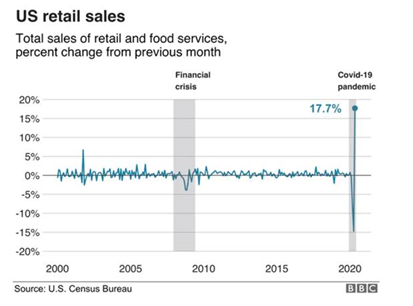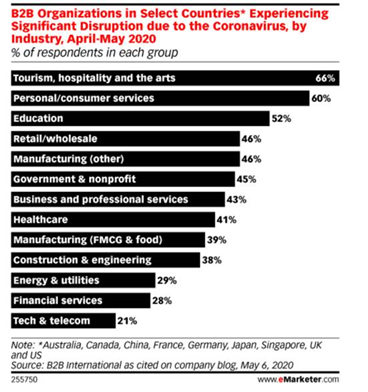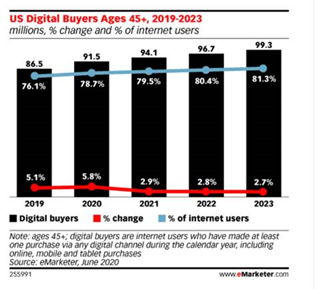August Round-up: Better Meta Targeting, Google Glitch & UX Best Practice
The latest version of our newsletter should have settled in your email inbox, detailing the need-to-know information and must-read thought leadership...
Read moreWhat are the latest news stories from the world of international marketing? From growth opportunities exploding post-pandemic to how prioritisation of brand value could aid post-COVID recovery, read more.
What's new, important and interesting in international marketing? This week we look at variations in global consumer purchasing trends as we emerge from lockdown, how B2B businesses have weathered the storm of COVID-19, forecasts into how e-commerce could grow in 2020 following the mass shift to online spending, and shifts in brand positions on the Brand-Z top 100 global brands list.
Econsultancy report that the opening of non-essential UK stores coincides with a drop in European e-commerce trends of 54% for week ending 21st June. Although, sales were 34% higher than the first week of March’s pre-pandemic benchmark.
US retail spend saw a resurgence in May coming in at 17.7% higher than April. However, this has not yet recouped the year to date decrease of 6% YoY.

Data from GlobalWebIndex indicates that luxury goods are likely to be a priority purchase amongst Indian, Chinese and South African consumers, as they continued spending at conservative levels during lockdown.
During the three month height of the pandemic period, US retailers drove a 126% YoY rise in online revenue. The Nordics saw online revenue soar to 166%, while the rest of Europe drove a 115% increase. This indicates the favourable conditions of considering The Nordics as a potentially lucrative export opportunity.
China’s purchase behavioural shift to online looks set to remain post lockdown. JD.com saw online sales double YoY on the first day of their 618 Grand Promotion. A heavy increase in ecommerce live-streaming and sales promotions is likely to have impacted heavily on this.
A recent study by Survata found that 64% of US consumers are considering purchasing named brands over generic products. Reasons cited for this are perceived availability and trustworthiness of brand.
89% of multinationals have cut their ad spend budgets. The World Federation of Advertisers research indicates that smaller brands are more likely to maintain their investment in online advertising.
Kids aged 4 to 15 in the UK, US and Spain have spent as much time watching TikTok videos as they did on YouTube over February, March and April, showing the growth in popularity of the platform.
People seeking to de-stress through listening to music drove a 33% increase in active Spotify users in Q1.
eMarketer investigate the impacts of the pandemic on the slightly under reported B2B industry sectors.
Naturally, B2B businesses across the below markets operating in the travel and tourism sector have seen revenue floor. However, personal services (60%), education (52%), wholesale (46%) and manufacturing (46%) have also suffered heavily. Meanwhile tech and telecom (21%), financial services (28%) and energy and utilities (29%) have weathered the storm with lesser impact to their daily operations.

A survey carried out by McKinsey and Company in April has shown that 55% of respondents expect to see economic improvements in 2-3 months with growth at pre-pandemic levels. Only 33% felt economic growth would take 6-12 months or longer to recover.
Results from a Marketing Week and Econsultancy joint survey cite the ease of shifting to remote working compared to their B2C counterparts as being a key driver for lessening the negative impact of the virus on their operation.
eMarketer predict the volume of US digital consumers to grow by 7.4 million this year. Mass temporary store closures have forced US consumers to shop online where they may not have done so before. 204 million people are anticipated to transact online in 2020 with two thirds of these users being over 45. This represents a 5.8% rise in digital buyers over 45, which is up from 3.2% last year equating to nearly 5 million new online customers.

Salesforce’s US consumer survey in May highlighted that baby boomers had used contactless delivery more than usual, followed by self-checkout options (23%) and click-and-collect (23%).
Although in-store shopping is gradually expected to start to normalise, consumers who have tried shopping online may feel more inclined to stick with it.
Jing reflect on the successful growth of top Chinese brands post COVID-19, with Alibaba and Tencent ranking 6th and 7th on BrandZ top 100 brands list. Huawei, TikTok, Meituan and Moutai sought not to be outdone and joined them in slightly more modest positions for the first time.
Doreen Wang, Global Head of BrandZ, cited that increasing their perceived value and undertaking digital transformation are the key to successful growth, while 70% of brand leaders interviewed by BrandZ feel that brands need to revamp their logistics, supply chain and their entire operations to see continued growth and success.
Wondering how international marketing might benefit your brand? Book in a conversation with our experts today to learn which markets are best for your business.
More articles you might be interested in:

The latest version of our newsletter should have settled in your email inbox, detailing the need-to-know information and must-read thought leadership...
Read more
As the cost of living continues to present challenges for many Brits, an increasing number of families are choosing to holiday within the United...
Read more
Our first curated newsletter has hit inboxes, detailing all of the latest need-to-know information and sharing all the necessary thought leadership...
Read more
Over the past few years, marketing leaders have been gearing up for the inevitable 'Cookieless Future'. Safari was the first to bid farewell to...
Read more.png)
It only seems like yesterday that it was the winter of 2022 and we were balancing Black Friday and the Qatar World Cup. Fast forward to now and we're...
Read more
There are many factors to consider when choosing an automotive dealership, with 53% of customers saying that price determines which dealership they...
Read more
Which UK-based private healthcare providers are running away with their digital presence and who needs a helping hand to take the next step? How is...
Read more.jpg)
How prepared are you for planning & budgeting season? Dave Chaffey shares some of the questions you should ask yourself when planning marketing...
Read more